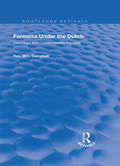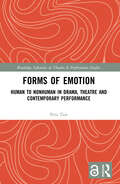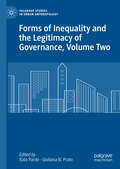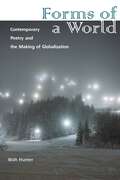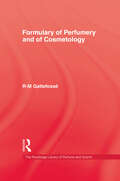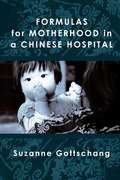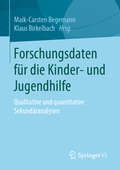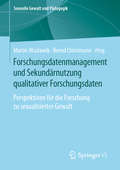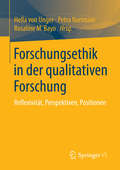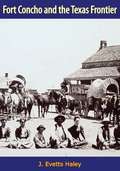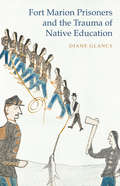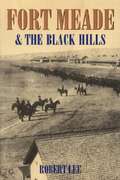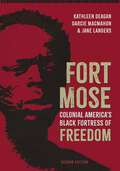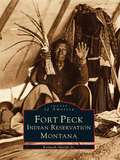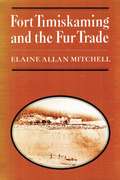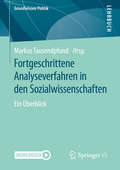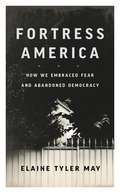- Table View
- List View
Formosa Under the Dutch: Described from Contemporary Records with Explanatory Notes and a Bibliography of the Island (Routledge Revivals)
by William CampbellFirst published in 1903, this volume explored the history of Formosa (now Taiwan) under Dutch occupation between 1624 and 1661, along with shedding some light on its early history. As missionaries were again at work in Formosa, the author found it useful to understand the fate of the island’s previous Catholic colonisation. Part 1 is composed from the Oud en Niew Oost-Indian by Franҫois Valentyn and covers topography, trade and religion. Part 2 covers Catholic Missions to the Island and sheds some light on the issues they faced related to having no vernacular Bibles and other methods of conversion. This will be of particular interest to students and researchers of Catholic world conversion efforts under the Counter-Reformation, in comparison to similar efforts elsewhere in Asia such as Japan, China and India. Part 3 narrates the events which led up to, and culminated in, the nine months’ siege of Fort Zeelandia which ended the rule of the Dutch East India Company over what is now Taiwan.
Forms of Emotion: Human to Nonhuman in Drama, Theatre and Contemporary Performance (Routledge Advances in Theatre & Performance Studies)
by Peta TaitForms of Emotion analyses how drama, theatre and contemporary performance present emotion and its human and nonhuman diversity. This book explores the emotions, emotional feelings, mood, and affect, which make up a spectrum of ‘emotion’, to illuminate theatrical knowledge and practice and reflect the distinctions and debates in philosophy, neuroscience, psychology, and other disciplines. This study asserts that specific forms of emotion are intentionally unified in drama, theatre, and performance to convey meaning, counteract separation and subversively champion emotional freedom. The book progressively shows that the dramatic and theatrical representation of the nonhuman reveals how human dominance is offset by emotional connection with birds, animals, and the natural environment. This book will be of great interest to students and researchers interested in the emotions and affect in dramatic literature, theatre studies, performance studies, psychology, and philosophy as well as artists working with emotionally expressive performance.
Forms of Inequality and the Legitimacy of Governance, Volume One (Palgrave Studies in Urban Anthropology)
by Italo Pardo Giuliana B. PratoThis edited volume uses ethnographic cases to examine social, political, and economic inequality in diverse urban settings. This book is couched in the idea that ethnographically based analysis helps to bring out the nature and interconnections between different forms of inequality and sheds light on the major forces that combine to create inequalities. Ethnography also helps to identify the dynamics that undergird the principle of freedom of thought and of action—a key principle, that is, of associated life in a democracy—and recognize empirically that these dynamics not only protect difference but increase it, for they underpin the freedom of the individual to use their talents to manage their lives and achieve their goals. This first volume in a two-part series focuses on legitimacy, governance, labour and urban change, and stereotypes and individual choice. This book will be of interest to scholars and students in sociocultural anthropology, sociology, politics, socio-legal studies, urban change, and education.
Forms of Inequality and the Legitimacy of Governance, Volume Two (Palgrave Studies in Urban Anthropology)
by Italo Pardo Giuliana B. PratoThis edited volume uses ethnographic cases to examine social, political, and economic inequality in diverse urban settings. This book is couched in the idea that ethnographically-based analysis helps to bring out the nature and interconnections between different forms of inequality and sheds light on the major forces that combine to create inequalities. Ethnography also helps to identify the dynamics that undergird the principle of freedom of thought and of action — a key principle, that is, of associated life in a democracy — and recognize empirically that these dynamics not only protects difference but increase it, for they underpin the freedom of the individual to use their talents to manage their lives and achieve their goals. This second volume in a two-part series focuses on housing and residential patterns, development and urban regeneration, and education. This book will be of interest to scholars and students in sociocultural anthropology, sociology, politics, socio-legal studies, urban change, education.
Forms of a World: Contemporary Poetry and the Making of Globalization
by Walt HunterWhat happens when we think of poetry as a global literary form, while also thinking the global in poetic terms? Forms of a World shows how the innovations of contemporary poetics have been forged through the transformations of globalization across five decades. Sensing the changes wrought by neoliberalism before they are made fully present, poets from around the world have creatively intervened in global processes by remaking poetry’s formal repertoire. In experimental reinventions of the ballad, the prospect poem, and the ode, Hunter excavates a new, globalized interpretation of the ethical and political relevance of forms. Forms of a World contends that poetry’s role is not only to make visible thematically the violence of global dispossessions, but to renew performatively the missing conditions for intervening within these processes. Poetic acts—the rhetoric of possessing, belonging, exhorting, and prospecting—address contemporary conditions that render social life ever more precarious. Examining an eclectic group of Anglophone poets, from Seamus Heaney and Claudia Rankine to Natasha Trethewey and Kofi Awoonor, Hunter elaborates the range of ways that contemporary poets exhort us to imagine forms of social life and enable political intervention unique to but beyond the horizon of the contemporary global situation.
Formulary of Perfumery and Cosmetology
by GattefosseFirst published in 2006. Routledge is an imprint of Taylor & Francis, an informa company.
Formulas for Motherhood in a Chinese Hospital
by Suzanne GottschangWhat happens to pregnant women when the largest country in the world implements a global health policy aimed at reorganizing hospitals and re- training health care workers to promote breastfeeding? Since 1992, the Chinese government has led the world in reorganizing more than 7,000 hospitals into “Baby- Friendly” hospitals. The initiative’s goal, overseen by UNICEF and the World Health Organization, is to promote the practice of breastfeeding by reorganizing hospital routines, spaces, and knowledge in maternity wards and obstetrics clinics. At the same time, China’s hospitals in the mid- 1990s operated as sites where the effects of economic reform and capitalism increasingly blurred the boundaries between state imperatives to produce healthy future citizens and the flexibility accorded individuals through their participation in an emerging consumer culture. Formulas for Motherhood follows a group of women over eighteen months as they visited a Beijing Baby- Friendly Hospital over the course of their pregnancies and throughout their postpartum recoveries. The book shows how the space of the hospital operates as a microcosm of the larger social, political, and economic forces that urban Chinese women navigate in the process of becoming a mother. Relations between biomedical practices, heightened expectations of femininity and sexuality demanded by a consumer culture, alongside international and national agendas to promote maternal and child health, reveal new agents of maternal governance emerging at the very moment China’s economy heats up. This ethnography provides insight into how women’s creative pragmatism in a rapidly changing society leads to their views and decisions about motherhood.
Forschungsdaten für die Kinder- und Jugendhilfe: Qualitative und quantitative Sekundäranalysen
by Klaus Birkelbach Maik-Carsten BegemannDer Sammelband arbeitet das bislang unterschätzte, jedoch zunehmend an Bedeutung gewinnende Potenzial von Sekundäranalysen in der Kinder- und Jugendhilfe heraus. Dazu werden nicht nur verschiedene, bereits durchgeführte Analysen präsentiert, sondern auch Möglichkeiten für eigene Sekundärauswertungen – beispielsweise durch Beschreibung des Zugangs zu kontinuierlich erhobenen Daten – aufgezeigt.Der InhaltGrundlagen • Regelmäßig erhobene Querschnittsdaten und Panelstudien • Daten der amtlichen Statistik • Akten und andere Dokumente • Systematische Auswertungen verschiedener Studien und unterschiedlicher Datenquellen zu spezifischen Themen • Trägerstatistiken • Sozialraumbezogene Daten • DatenarchiveDie HerausgeberDr. Maik-Carsten Begemann ist aktuell Lehrbeauftragter am Fachbereich Sozial- und Kulturwissenschaften der Hochschule Düsseldorf.Dr. Klaus Birkelbach ist Professor für Soziologie am Institut für Soziale Arbeit und Sozialpolitik der Universität Duisburg-Essen.
Forschungsdatenmanagement und Sekundärnutzung qualitativer Forschungsdaten: Perspektiven für die Forschung zu sexualisierter Gewalt (Sexuelle Gewalt und Pädagogik #6)
by Martin Wazlawik Bernd ChristmannDer Band nimmt Fragestellungen zum Umgang mit Forschungsdaten zu sexualisierter Gewalt auf und versucht eine Bestimmung notwendiger forschungsethischer Positionen. Es geht dabei auch um den Beitrag, den Sekundärauswertungen von qualitativen Materialbeständen zu Forschungsfragen leisten können, die methodischen und methodologischen Limitationen und forschungsethischen Herausforderungen sowie um die Problematik, dabei die Selbstbestimmung und Selbstdeutungshoheit von Betroffenen von sexualisierter Gewalt unter einer Partizipationsperspektive zu wahren.
Forschungsdesign in der Politikwissenschaft: Eine Theorieorientierte Perspektive Mit Anwendungsbeispielen (Essentials)
by Steffen GanghofDas essential unterscheidet drei grundlegende Typen sozialwissenschaftlicher Forschungsdesigns: x-zentriert, y-zentriert und kontrastiv. Diese unterscheiden sich durch die Anzahl der betrachteten Theorien und dadurch, ob diese Theorien logisch konkurrierend oder komplementär sind. Keines der drei Designs ist den anderen eindeutig überlegen, da sie unterschiedliche Annahmen treffen und unterschiedliche Zielsetzungen verfolgen. Sie können sich deshalb sinnvoll ergänzen, auch innerhalb einzelner Studien, wenn dabei bestimmte Fallstricke beachtet werden. Das essential diskutiert die drei Designs anhand von 14 qualitativen und quantitativen Beispielstudien aus der Politikwissenschaft und den internationalen Beziehungen.
Forschungsethik in der qualitativen Forschung
by Hella Von Unger Petra Narimani Rosaline M´bayoWie verhalten sich Forschende im Forschungsfeld? Wie nehmen sie ihre Verantwortung als Forschende wahr? Wie gestalten sie die Beziehungen zu den Teilnehmenden und berücksichtigen deren Rechte? In diesem Sammelband reflektieren AutorInnen methodische und forschungsethische Fragen, die sich in ihrer qualitativen Forschungspraxis stellen. Sie nehmen unterschiedliche Positionen und Perspektiven ein und diskutieren forschungsethische Grundsätze wie das informierte Einverständnis.
Forschungsmethoden in Psychologie und Sozialwissenschaften für Bachelor
by Margrit Schreier Gerald Echterhoff Walter Hussy Jana F. Bauer Nicole WeydmannDieses Lehrbuch bietet einen leichten Einstieg und verständlichen Gesamtüberblick über die quantitativen und qualitativen Methoden der Psychologie und angrenzender Sozialwissenschaften: alle wichtigen Verfahren, ihre Logik und Einsatzgebiete, Stärken und Schwachpunkte und auch neuere Entwicklungen. Methoden sind das Fundament der Psychologie und aller Sozialwissenschaften und deshalb allgegenwärtig im Studium. Doch das Thema weckt bei manchen auch Sorgen, insbesondere wenn unter Zeit- und Erfolgsdruck gelernt werden muss. Aber: Keine Angst vor den Forschungsmethoden! Die 3. Auflage wurde vollständig überarbeitet und enthält Fallbeispiele, Definitionen, Tipps für die Praxis, Lernziele, Kontrollfragen und vertiefende Literatur. Lern-Tools für Studierende sowie Abbildungen und Foliensätze zum Download für Dozierende finden sich darüber hinaus auf www.lehrbuch-psychologie.springer.com.
Forschungsmethoden in der Gesundheitsförderung und Prävention
by Marlen Niederberger Emily FinneUm als Schnittstelle zwischen Wissenschaft und Praxis geeignete Interventionen zu identifizieren, zu entwickeln, umzusetzen und zu evaluieren, benötigen Gesundheitsförderung und Prävention unter anderem Theorien, eine zuverlässige Evidenzlage, aktuelle empirische Daten, subjektorientierte Ansätze und partizipative Instrumente. In diesem Kontext spielen qualitative und quantitative Forschungsmethoden sowie inter- und transdisziplinäre Sichtweisen eine wichtige Rolle. Dieses Buch gibt einen Überblick über wichtige Forschungsmethoden in der Gesundheitsförderung und Prävention.
Forschungsstrategien in den Sozialwissenschaften: Eine Einführung
by Markus TausendpfundTrotz unterschiedlicher Themen und Fragestellungen sind Forschende und Studierende bei der Durchführung eines Forschungsprojekts immer wieder mit vergleichbaren Herausforderungen konfrontiert: eine relevante Forschungsfrage muss entwickelt und der meist umfangreiche Forschungsstand prägnant präsentiert werden. Daran anknüpfend müssen die zentralen Konzepte eines Forschungsprojekts spezifiziert und valide Operationalisierungen dieser Konzepte entwickelt werden. Schließlich müssen Untersuchungsobjekte ausgewählt und die geeignete Untersuchungsmethode festgelegt werden. Dieser Band behandelt die typischen Herausforderungen eines sozialwissenschaftlichen Forschungsprojekts und bietet Informationen, um diese Herausforderungen (besser) meistern zu können.
Fort Concho and the Texas Frontier
by J. Evetts HaleyThis book, which was first published in 1952, first began as a history of San Angelo and the adjacent region drained by the Conchos rivers. It grew, in writing, into a history of West Texas. It embodies author J. Evetts Haley’s unequaled knowledge of the country from the Rio Grande to the Canadian, from San Antonio and Austin to the border of New Mexico.It could have been written only by a man familiar by personal acquaintance with the location of every water hole and spring, the exploration of every trail from Coronado’s to the Overland Mail, the great cattle drives of the seventies and eighties, the establishment of every military post, and the shifting Indian policies of the United States from the annexation of Texas to the final retirement of the Comanches to the Indian Territory (now Oklahoma). Haley has an intimate knowledge of hundreds of salty characters who played their picturesque roles in transforming the land from nature to civilization.Haley possesses all this equipment—gained from intensive study, personal experience, and thoughtful reflection—for writing a vivid story. Five previous books and unnumbered articles on phases of the region contribute to the facility with which he tells this stirring tale and account of its comprehensiveness. It is no less than a history of West Texas in its heroic age.
Fort Laramie: Military Bastion of the High Plains
by Douglas C. McchristianMcChristian (author and retired historian, National Park Service) provides a complete military history of Fort Laramie, one of America's most venerated historic places. The book details every stage of the fort's existence, from its beginnings in 1834 as a trading post, its involvement in the buffalo hide trade, overland migrations, Indian wars and treaties, the Utah War, and into the telegraph and first transcontinental railroad eras. It also includes previously untold stories, such as the 1874 murder of Lieutenant Levi Robinson. The book also includes photographs of the fort, its surroundings, and the personalities who were involved with it. Annotation ©2009 Book News, Inc., Portland, OR (booknews.com)
Fort Marion Prisoners and the Trauma of Native Education
by Diane GlancyAt the end of the Southern Plains Indian wars in 1875, the War Department shipped seventy-two Kiowa, Cheyenne, Arapaho, Comanche, and Caddo prisoners from Fort Sill, Oklahoma, to Fort Marion in St. Augustine, Florida. These most resistant Native people, referred to as “trouble causers,” arrived to curious, boisterous crowds eager to see the Indian warriors they knew only from imagination. Fort Marion Prisoners and the Trauma of Native Education is an evocative work of creative nonfiction, weaving together history, oral traditions, and personal experience to tell the story of these Indian prisoners.Resurrecting the voices and experiences of the prisoners who underwent a painful regimen of assimilation, Diane Glancy’s work is part history, part documentation of personal accounts, and a search for imaginative openings into the lives of the prisoners who left few of their own records other than carvings in their cellblocks and the famous ledger books. They learned English, mathematics, geography, civics, and penmanship with the knowledge that acquiring the same education as those in the U.S. government would be their best tool for petitioning for freedom. Glancy reveals stories of survival and an intimate understanding of the Fort Marion prisoners’ predicament.
Fort Meade and the Black Hills
by Robert LeeFort Meade was the home of the famous Seventh Cavalry after its ignominious defeat in the Battle of the Little Bighorn. Troops from Fort Meade played a pivotal role in the events that led to the tragedy at Wounded Knee in 1890. It was the scene of imprisonment of Ute Indians who made the mistake of interpreting their new citizenship status as freedom from government control. The fort survived the mechanization of the horse cavalry, aided the record-breaking Stratosphere Balloon flight of 1935, and became a training site for the nation's first airborne troops. Fort Meade existed for sixty-six years, from 1878 to 1944. Robert Lee examines the strategic importance of its location on the northern edge of the Black Hills and the role it played in the settlement of the region, as well as the role played by the citizens of Sturgis in keeping it alive. One of the chief delights of Fort Meade and the Black Hills is a gallery of characters including the unfortunate Major Marcus Reno, the beautiful and fatal Ella Sturgis, and the cigar-smoking Poker Alice Tubbs. They, and events scaled to their larger-than-life size, are part of this long overdue story of Fort Meade. Robert Lee has published several books and many articles on South Dakota's history. Inducted into the South Dakota Hall of Fame in 1987, he was named its writer of the year in 1992.
Fort Mose: Colonial America's Black Fortress of Freedom, Second Edition (Florida Humanities Partnership Publications)
by Jane Landers Kathleen Deagan Darcie MacMahonThe illustrated story of the history and groundbreaking discovery of an important historical site, fully updated on the 30th anniversary of its first publication
Fort Peck Indian Reservation, Montana
by Kenneth Shields Jr.For generations, the Native American people have been a society of great mystery. The Assiniboine and Sioux Indians of the Fort Peck Reservation in northeastern Montana are no exception. Althoughcenturies old, their culture is only now being rediscovered and explored. The idea to reveal some of their fascinating story stemmed from the desire,devotion, and dedication of a few individuals to embrace the opportunity to explore this wondrous race of people. In 1851 at Fort Laramie, Wyoming, the tribes of Montana and Dakota territories signed a treaty with the U.S. Government, which led to thebeginnings of many congressional hearings concerning Native American reservations. In 1886 at Fort Peck Agency, the Sioux and Assiniboine exerted their sovereign powers and agreed with the government to create the Fort Peck Indian Reservation. After much negotiation over the two million acres of land, U.S. Congress ratified the agreement in 1888. This colorful heritage and legacy of Fort Peck is commemorated by the 200 images in this photographic collection. Featured are scenes of tribal leaders, schoolchildren, families, and celebrations from the late 1880s to the 1920s. All of the images were provided by Native American families living on the Fort Peck Reservation, the Fort Peck Tribal Archives, and the Montana Historical Society.
Fort St. Joseph Revealed: The Historical Archaeology of a Fur Trading Post
by Michael S. NassaneyFort St. Joseph Revealed is the first synthesis of archaeological and documentary data on one of the most important French colonial outposts in the western Great Lakes region. Located in what is now Michigan, Fort St. Joseph was home to a flourishing fur trade society from the 1680s to 1781. Material evidence of the site—lost for centuries—was discovered in 1998 by volume editor Michael Nassaney and his colleagues, who summarize their extensive excavations at the fort and surrounding areas in these essays. Contributors analyze material remains including animal bones, lead seals, smudge pits, and various other detritus from daily life to reconstruct the foodways, architectural traditions, crafts, trade, and hide-processing methods of the fur trade. They discuss the complex relationship between the French traders and local Native populations, who relied on each other for survival and forged links across their communities through intermarriage and exchange, even as they maintained their own cultural identities. Faunal remains excavated at the site indicate the French quickly adopted Native cuisine, as they were unable to transport perishable goods across long distances. Copper kettles and other imported objects from Europe were transformed by Native Americans into decorative ornaments such as tinkling cones, and French textiles served as a medium of stylistic expression in the multi-ethnic community that developed at Fort St. Joseph. Featuring a thought-provoking look at the award-winning public archaeology program at the site, this volume will inspire researchers with the potential of community-based service-learning initiatives to tap into the analytical power at the interface of history and archaeology. Contributors: Rory J. Becker | Kelley M. Berliner | José António Brandão | Cathrine Davis | Erica A. D’Elia | Brock Giordano, RPA | Joseph Hearns | Allison Hoock | Mark W. Hoock | Erika Hartley | Terrance J. Martin | Eric Teixeira Mendes | Michael S. Nassaney | Susan K. Reichert
Fort Timiskaming and the Fur Trade (The Royal Society of Canada Special Publications)
by Elaine MitchellThe development of the fur trade in the Timiskaming district of northern Ontario has been largely overlooked until now, mainly because of the lack of records for the period before 1821. This gap has been partially filled by the discovery of private papers in the possession of the late Colonel Angus Cameron of Nairn, Scotland. His great granduncle and grandfather, as well as other memebrs of his family, were involved in the Timiskaming district for almost a century. These papers, plus the voluminous records of the Hudson's Bay Company, have provided the basis for the present study.Mrs Mitchell traces the history of Fort Timiskaming and its subsidiary posts from the first French establishments in the 1670s and 80s until 1870, when the Hudson's Bay territories became part of the new Dominion of Canada. She describes the exploitation of the posts by freetraders from Montreal after 1763, their purchase by the North West Company in 1795, the struggle between rival Canadian and English traders before 1821, and the events following the amalgamation in 1821 of the North West and Hudson's Bay companies.She also discusses the effect of the district's fortunes of petty traders, lumbermen, missionaries, and settlers, and offers a general picture of the country and of life at the posts. This is a work that will appeal not only to historians, but to all Canadians interested in Canada's early history.
Fortgeschrittene Analyseverfahren in den Sozialwissenschaften: Ein Überblick (Grundwissen Politik)
by Markus TausendpfundRegression, Faktorenanalyse, Qualitative Comparative Analysis oder auch Inhaltsanalyse – der Band gibt einen Überblick über wichtige Analyseverfahren, die häufig genutzt werden, um eine sozialwissenschaftliche Forschungsfrage zu bearbeiten. Dabei werden die einzelnen Verfahren nicht abstrakt dargestellt, sondern jeweils an konkreten sozialwissenschaftlichen Fragestellungen illustriert. Zudem werden die Voraussetzungen der Verfahren erläutert sowie Vor- und Nachteile diskutiert. Die Auseinandersetzung mit den unterschiedlichen Verfahren soll einerseits die passive Methodenkompetenz fördern und andererseits das Interesse wecken, sich intensiver mit den Verfahren zu beschäftigen.Zusätzliche Fragen per App: Laden Sie die Springer Nature Flashcards-App kostenlos herunter und nutzen Sie exklusives Zusatzmaterial, um Ihr Wissen zu prüfen.
Fortney Road: Life, Death, And Deception In A Christian Cult
by Jeff C. Stevenson<P>"A fascinating and disturbing look into the world of vicious cults and the psychological damage they inflict." <P>-Jonathan Kellerman Fortney Road is a disturbing account of calculated mental, physical, and sexual abuse in an evangelical Christian cult.<P> Drawing on seven years of research including interviews with seventeen survivors, it tells the story of the rise and fall of the Church of the Risen Christ, its sadistic leader the Reverend Larry Hill, and its outreach tool The All Saved Freak Band, one of the earliest religious rock groups borne out of the Jesus Movement.<P> Unfolding against the backdrop of the 1960s and early '70s, Fortney Road is also the story of one brilliant musician who fell victim to a charismatic, cruel zealot. <P>While other cult leaders such as David Koresh and Jim Jones have become infamous, Larry Hill and his followers on Fortney Road have flown largely under the radar-until now. Illustrated with over 50 photographs and images.
Fortress America: How We Embraced Fear and Abandoned Democracy
by Elaine Tyler MayAn award-winning historian untangles the roots of America's culture of fear, and argues that it imperils our democracyFor the last sixty years, fear has seeped into every area of American life: Americans own more guns than citizens of any other country, sequester themselves in gated communities, and retreat from public spaces. And yet, crime rates have plummeted, making life in America safer than ever. Why, then, are Americans so afraid-and where does this fear lead to?In this remarkable work of social history, Elaine Tyler May demonstrates how our obsession with security has made citizens fear each other and distrust the government, making America less safe and less democratic. Fortress America charts the rise of a muscular national culture, undercutting the common good. Instead of a thriving democracy of engaged citizens, we have become a paranoid, bunkered, militarized, and divided vigilante nation.
